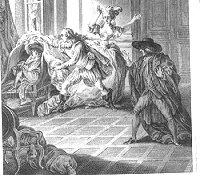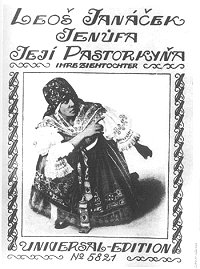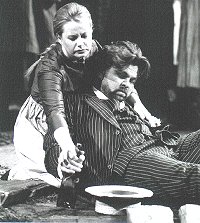This year's season at Glyndebourne started with a bang, but, sadly, not with the kind of bang one would have expected from this beloved Opera Festival in the Sussex Downs, especially as Glyndebourne´s historically most important opera, Mozart´s Le nozze di Figaro, was at stake.

[Engraving from Beaumarchais]
In 1934, John Christie chose this work to inaugurate his Festival (with Fritz
Busch in the pit and Carl Ebert directing), whilst in 1994, his son Sir George
Christie opened the new house with Figaro. As a prelude to the 21st
century, it seemed appropriate to keep this tradition alive. But tradition
for its own sake and without any artistic substance is a disturbing
misunderstanding. Each year I come to Glyndebourne, I visit first the Organ
Room and bow in front of the refreshing portrait of the young Mozart. What
may have been his thoughts after the curtain had come down over the
Figaro disaster this year if he were able to listen and follow the action
on a celestial TV screen?
At the end of this season, Sir Andrew Davis, Music Director since 1988, and Graham Vick, Director of Productions since 1993, will leave Glyndebourne, the former only being replaced when the right personality can be found, the latter not being replaced at all, for the sake of versatility. As both were in charge of the Cosi fan tutte production(1998), revised this year, and as both are responsible for Figaro and Don Giovanni (premiere July 15), to confront us with their version of the so called Da Ponte Operas, I am quite relieved about their departure. Maybe, those works will have a well deserved rest for a while. (In case Nicolas Snowman, the new General Director, should find a real Mozart conductor, there are so many more of his operas never performed here.)
Every opera performance is as good as its conductor. He has not necessarily to be a dictator, but he has to command a fundamental inner relationship with the music and be able to breathe and communicate its pulse, without ever losing control or giving in to what ever could hamper the musical intentions. Opera is about music, and only about music, which nowadays is easily forgotten in an age dictated by the ego of directors or designers. But as long as there is a strong personality in the pit caring for the composer and able to deliver, and to convince orchestra and singers, an opera will always fully come to life even with the most destructive stage directions or an uneven cast.
With Andrew Davis I have rarely felt a hundred per cent comfortable. He is extremely versatile (maybe a bit too versatile) and he has a boundless repertoire, being able to conduct any score, but on this occasion (as with Cosi two years ago) the tempi fluctuated far too often, or got slower and slower, and ensemble scenes fell apart. The constant dramatic impact of the musical structure got lost and, worse, it sounded boring.
He seemed more concerned with coping with the director's instructions, which, for example, killed the entire finale of the second act. For me, the first few bars of a prelude or the precision and understanding of an overture are the clearest indication of what to expect. Davis conducted the overture not as a synopsis. There was no danger, nor a real understanding of the speed - it all sounded pretty (and later in the opera it did not even sound pretty anymore) but irrelevant. Let us go back and listen to Fritz Busch.
Graham Vick, who some years ago gave us with Figaro´s Wedding in English (and with an inspired Paul Daniel in the pit) a contemporary, but incredibly theatrical and meaningful interpretation at the ENO, seemed to have run out of steam. Over the last years I felt more and more that his theatrical approach has burned out, only to be replaced by an intellectual approach. His Cosi, placed on a rehearsal stage in rehearsal costumes had been entirely out of tune with Mozart. Stupid enough, I was so much looking forward to Figaro it never crossed my mind that he may have similar intentions for all three Da Ponte Operas! (By the way, why Da Ponte Operas?? Nobody ever talks about Hofmannsthal Operas in connection with Richard Strauss.) But with shadows running or walking across the stage behind the curtain during the overture, trying to tell us that there may be a hectic and terror driven action awaiting us, I had a foreboding of what to expect.
Vick´s chosen team was again Richard Hudson(design), Jennifer Tipton(lighting) and Ron Howell(movement). Of course, the moment the curtain went up, there was the Cosi rehearsal stage again, with its two old fashioned radiators on the back wall and the two slender columns supporting the ceiling. Five white rectangular walls, covered with see-through gauze and each part with a black doorframe, together with five arm-chairs in each of the five half cubicles filled the stage. In the background, a white horse seemed to build the forthcoming connection to Don Giovanni.
In this cage like design, where one could enter or exit through the doorframes or avoid them, without any clear logic, nobody trusted anybody; everybody could be watched and followed. Four servants behaved like MI5 agents shadowing everybody. Later, in the fourth act they were hanging in the walls, now being placed in an oblique position from the grid, making awful musical noises suggesting the mad and spooky atmosphere of the nightly daylight lit game of who finds whom together with whom - a black comedy in the style of Figaro´s Wedding, but far more confusing. Whoever did not know the story was left in the dark.
Even I had been flabbergasted about certain solutions. In Act two, when Cherubino has to flee the Count, he jumped into the orchestra pit or somewhere close to it. Nevertheless, the audience laughed a lot, without any obvious reason. Finally, I discovered that they had been intensively studying the supertitles, which went totally over the top.
Endless symbolism, be it as props or in the way the characters acted or spoke to each other, irritated, made hardly any sense, and had no obvious connection to the music. For Glyndebourne, even the casting had been very uneven. I am sure, the cows and sheep outside in the rain enjoyed the huge voice of the handsome and tall Swedish Figaro Peter Matei as much as the audience. His domination was specifically difficult for Christiane Oelze, last year's Mélisande, who was miscast as Susana. The Polish Count Almaviva Mariusz Kwiecien had a promising voice, but to portray him in his aria E Susanna non vien as a kind of Scarpia or Iago is utter nonsense. The Italian soprano Maria Costanza Nocentini (Countess) seemed shy and not too happy; Andrew Davis conducted her two arias so slowly that she had to use far too much vibrato. Another Italian soprano, Marina Comparato, gave a breathtaking Cherubino - a life-wire with a beautifully proportioned voice. Andrew Shore (Bartolo), Diana Montague (Marcellina), Ryland Davies (Don Basilio) and David Gwynne (Antonio) were all excellent on their own, but the whole cast lacked the necessary coherence for such an ensemble opera.
The London Philharmonic played with its usual strength and refinement - the sound of the cello continuo by Susanne Beer impressed. But with Andrew Davis being more interested in keeping in line with Graham Vick, than acting as Mozart´s servant, any real judgement is difficult. The idea of having to cope with two further Mozart operas by the same team is hard to digest. Before I left, I said good bye to the young Mozart in the organ room and I heard him whisper: "Why are they doing it to me here, where I am at home ever since Fritz Busch took care of me?"
Hans-Theodor Wohlfahrt

[Jenufa - cover of score]
I am pleased to offer readers of S&H two reports
of this year's outstanding Jenufa at Glyndebourne. I have just one
additional comment: - unlike Hans-Theodor Wohlfahrt, I found the sur-titles
excellent, providing key sentences at just the right moment to clarify the
complex action and emotions. Perhaps seeing the performance from high up
(excellent for sight and sound) helped, because the sur-titles were comfortably
within the field of vision and did not provoke divided attention.
(PGW, Editor).
Janácek Jenufa Glyndebourne Festival Opera, 21 May 2000 (HTW)
With its second premiere this season, the Glyndebourne Festival Opera brought Leos Janácek's Jenufa back into the repertoire. Originally staged in the old opera house in 1989, it had been a huge success then. Now, with a slightly extended design, it brought the new house down. The first night will most probably count as one of the greatest music theatre experiences in the entire history of Glyndebourne and certainly as the most accomplished evening in the new house. There may, hopefully, be similar highlights in the future, but no better ones.
Everybody instrumental in this overpowering event, born entirely out of the music, not only gave his or her best, but with a rare unselfishness integrated and submitted themselves to translate this music drama into the highest possible voltage. However, it is difficult to imagine that Janácek's first opera would have made such an impact without the Czech conductor Jirí Belohlávek, a frequent visitor to this country and currently Principal Guest Conductor of the BBC Symphony as well as of the Prague National Theatre. He was conducting at Glyndebourne for the first time. His insight into Janácek's sublime musical language and speech melodies created dimensions of clarity, transparency and tension, which never overshadowed the stage, but forced orchestra and singers to follow his intentions and, therefore, gave the music all the space to breathe and to develop. Under his baton the London Philharmonic played with magical intensity. Contrary to many excellent Janácek interpreters, Belohlávek avoided heaviness, preferring a subtle sound structure instead, which made everybody listen and asked for utmost concentration.
Generally in favour of supertitles, this time I would have been grateful if the projector had broken down. The text projections distracted from the sensual impact the music and the relevant stage action created. Instinctively one understood the unfolding of the drama and, at least for me, the sudden dinner interval came as a shock.
For once, not even the smallest part had been miscast. The ability of the entire cast to transform the musical lines into breath-taking theatre was even more astonishing. Janácek would have been extremely satisfied to hear how his speech melodies - a technique he learned, when he realised that anybody's speech had its own distinctive melody - became such remarkable reality.

[Jenufa & Steva - pict credit
MikeHoban]
With her first Jenufa Amanda Roocroft surpassed herself in every respect.
Her acting became natural and sensitive; any former restraint has turned
into a delicate obviousness full of charm and character, while her warm voice
and her range of colours were at ease and reached a yet unexpected beautiful
maturity. Anja Silja, by far the most fascinating singer-actress of
today, returned as Kostelnicka and gave again an unsurpassed interpretation
of this central, guilt-ridden character. It is due to her incredible
professionalism and her life-long stage experience that she never acts centre
stage, but always submits to the ensemble, even if she gives one the creeps
the moment she enters because of her overwhelming personality. Stefan
Margita (Laca) and Pär Lindskog (Steva) were as outstanding
as the rest of the cast. For a change, I have to give full marks to the director
Nikolaus Lehnhoff and his designer Tobias Hoheisel, who had
returned to polish this revival. Their view is true to the music, adding
to it a vital visual dimension which never distracts, but helps to underline
Janácek's intentions. Even with the last scene, when the village
population storms Kostelnicka's living-room and breaks all the furniture,
to take revenge for the murder of Jenufa´s baby, the direction never
goes over the top; it rather confronts with the behaviour, we experience
daily, be it road rage, hooliganism or human small-mindedness. Glyndebourne's
Jenufa is a must for everybody who loves opera and who believes that
this art form will have a future beyond becoming a museum.
Hans-Theodor Wohlfahrt
Janacek Jenufa Glyndebourne Festival Opera 14 June 2000 (AW)
The naturalistic staging designed by Tobias Hoheisel is to the point, sophisticated in its simplicity but never simplistic. It is entirely appropriate for this complex and emotionally involving period piece with timeless core elements. It not only sets off and enhances the drama but leaves space for the music to speak, to breathe and to sweep across the audience with great subtlety as well as great intensity.
The dimensions of Jenufa are personal, inward looking, as well as containing a wider social perspective. The main protagonists have an identity as a family group but a disturbed one. They have all been bereaved or orphaned, and relate as stepbrothers, stepdaughter and stepmother. This family tree is held together by the lone grandmother. Thus, loss and/or rejection surrounds the developing love triangle between Jenufa, Steva and Laca.
During the first act the set encloses them in the mill yard. Up front a stream slowly turns a large water wheel like the relentless stream of fate which flows through this contained world. Laca, the frustrated but steadfast lover, takes matters into his own hands in a climactic scene. He halts the wheel, spreadeagling himself across it, thereby hoping to intervene in its relentless progression which is not in his favour. This is a brilliant precursor to, and warning about, the act of violence which follows. Like a primitive kind of branding, he marks Jenufa as his own, by slashing and disfiguring her face with a knife. Stefan Margita's performance as Laca is spellbinding in its physical and vocal display of tension and frustration.
When the scene is transferred to Kostelnicka's home in the second act the windows are shuttered to keep the outside world at bay. The walls are a cold blue-green and a huge cupboard, its door wide open, reveals linen stacked with great precision, nothing out of line. At a glance it is made clear that Jenufa's illegitimate (out of order) baby cannot be accommodated within this neatly ordered setting. Anja Silja elicits eventual pity for the intimidating Kostelnicka, who murders Jenufa's baby. Her searing performance reveals intense conflicts as a guardian of social mores with concerns for her stepdaughter, and makes comprehensible her being forgiven at the end.
Amanda Roocroft managed to imbue Jenufa with an almost saintly dignity in the face of the emotional violence perpetrated on her by the weak and faithless Steva, the physical violence by Laca and the ultimate destructiveness of having her child murdered by her stepmother. Par Lindskos, as philandering Steva, gives a fine performance as the uncaring fellow, incapable of accepting responsibility, baffled by his eventual rejection by Karolka, his up-market conquest. Sarah Fox's impersonation of this flighty female brings a much needed light note and counterpoint to the sombre and serious events which unravel during the third act.
The lighting, designed by Wolfgang Gobel, tells the tale in its own terms of how events are shaping up and the emotional states of the protagonists. Vivid colours changed, faded, drained or started to glow, subdued colours gave way to a harsh light when, literally, things were about to be revealed.
All aspects of the elusive, cross-over art of opera were perfectly balanced, completely in tune and enhanced each other in this stunningly beautiful and harrowing revival of this famous Nikolaus Lehnhoff production of Janacek's miraculous Jenufa.
Alexa Woolf
 Return to:
Return to: